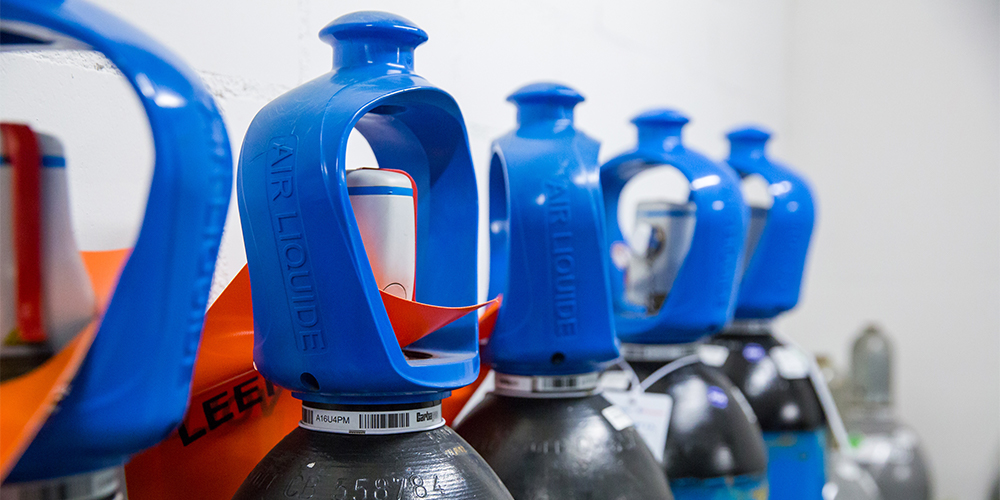Carbon footprint

The University of Basel emitted 49% fewer greenhouse gas emissions in 2020 compared with the previous year. The heavy restriction of air travel as a result of the coronavirus pandemic was primarily responsible for this development.
Anthropogenic greenhouse gases amplify the natural greenhouse effect and lead to a warming of the Earth's climate, with serious consequences for humanity and the environment. For this reason, the University of Basel has resolved to track and reduce its greenhouse gas emissions. Last year, the emphasis was put on improving the available data. The carbon footprint now encompasses not only energy-related emissions (electricity, heating, cooling), but also emissions caused by air travel and catering (number of meals provided). Both areas are of great importance. Catering and air travel are responsible for an average of approx. 7 % and 48 %, respectively, of the total carbon footprint. Electricity (6 %), heating (37 %) and cooling (1 %) account for the remaining emissions.
Decrease in emissions 2020
The university registered a decrease in emissions of about 49 % compared with the previous year, due to the coronavirus pandemic. The decisive factor was the approx. 80 % decrease in the number of flights, from 7,166 (in 2019) to 1,403 (in 2020). More information about air travel can be found in the section Mobility.
However, not only the pandemic is responsible for reducing greenhouse gas emissions. Since 2020, the university has purchased electricity exclusively with proof of origin from European hydropower; this has lowered electricity-related emissions by 17 % compared with 2019 – even though electricity consumption only dropped slightly, by 5 %. The reduction in electricity and heat consumption was rather modest despite the pandemic (heating -9 %) as, particularly in research buildings, electricity, heating, and cooling often cannot be reduced, despite the absence of researchers. The reason for this is energy-intensive equipment, such as high-performance refrigerators which could not be switched off. Details about the energy data can be found in the respective section of the Sustainability Report.
Greenhouse gas emissions per university member1 rose slightly by 6 % from 2018 to 2019, before dropping by 50 % in 2020. The increase in emissions between 2018 and 2019 can be explained by an increase in air travel (+3 %) and electricity consumption (+2 %). Greenhouse gas emissions per usable floor area rose slightly in 2019 (+4 %), before falling by 10 % in 2020.2 Emissions per usable floor area have been trending downward since 2017.3
The following table lists greenhouse emissions for each scope, converted into metric tonnes of CO2-eq.4
Carbon footprint in metric tonnes of CO₂-equivalents
Scope 1 - Direct emissions
82
103
129
94
2 %
-27 %
+15 %
Scope 2 - Indirect emissions: Energy demand
1'861
1’428
1’512
1’456
39 %
-4 %
-22 %
Scope 3 - Indirect emissions: Total
5’901
5’265
5’656
2’183
59 %
-61 %
-63 %
Scope 3 - Indirect emissions: Energy supply chain
1’762
1’430
1’498
1’380
37 %
-8 %
-22 %
Scope 3 - Indirect emissions: Catering
404
572
484
75
2 %
-85 %
-81 %
Scope 3 - Indirect emissions: Air travel
3’736
3’263
3’673
729
20 %
-80 %
-80 %
Total
7’845
6’796
7’296
3’734
100 %
-49 %
-52 %
Goals & actions
Reduce greenhouse gas emissions
Develop a plan to reduce greenhouse gas emissions; identify pathways to reduction and steps towards a climate-neutral campus
Sustainability Office
Facilities
Project management & engineering
Campus managers
Improve data on greenhouse gas emissions
Prepare a comparative greenhouse gas footprint for energy use, business trips and food service
Sustainability Office
[1] Full Time Equivalents (FTE) include the number of employees (100% = 1 FTE) and the number of students. Students are counted as 0.68 FTE. A total of 11,716 FTE was used for 2019 and 12,012 FTE for 2020.
[2] The calculation of emissions per usable floor area does not include emissions due to air travel and catering, as these are not related to buildings.
[3] The reason is the falling scope 1 and 2 emissions and the increase in usable floor area between 2017 and 2020.
[4] The carbon footprint was calculated according to the international guidelines of the Greenhouse Gas Protocol


